100 Years in the Making
1921–2021
Take a look back with us as the Greenville County Library System celebrates 100 years of public library service! The Greenville Public Library Association was chartered in May of 1921 to establish and maintain a free public library and to promote the “Modern Library Movement” in the City and County of Greenville. We celebrate our rich heritage today with a look back over the last 100 years.

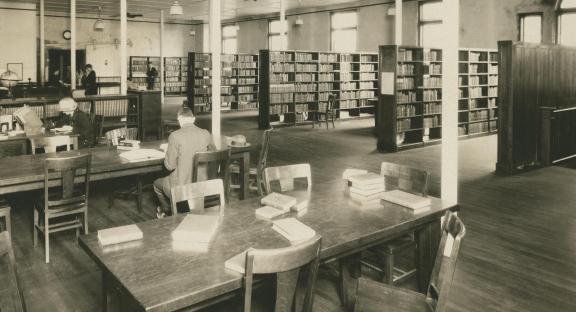

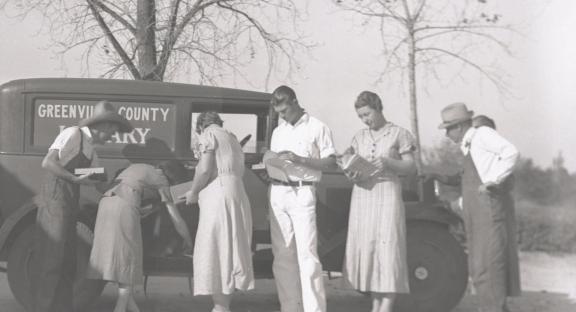


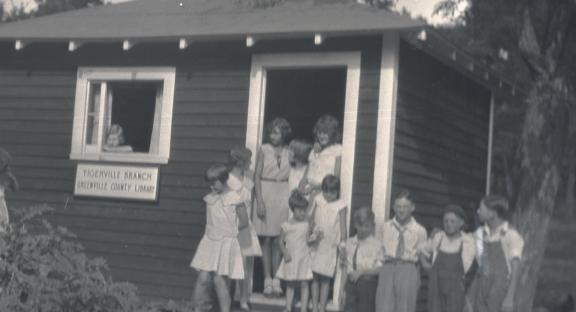
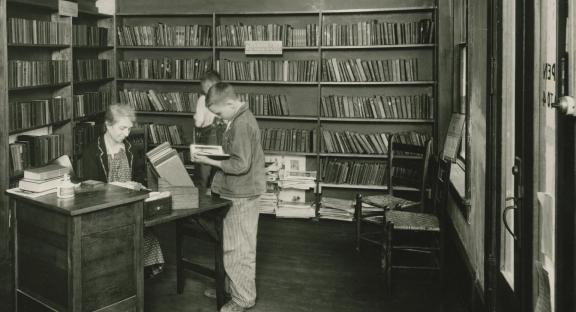



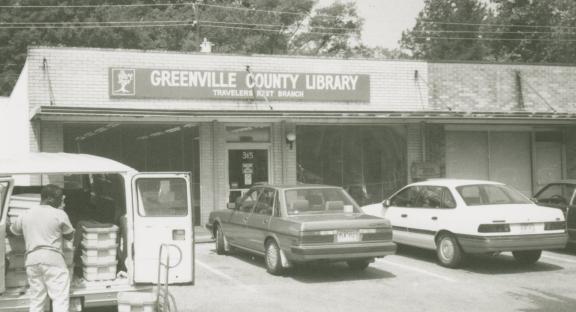
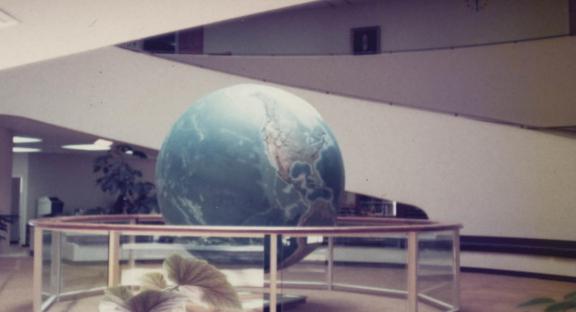
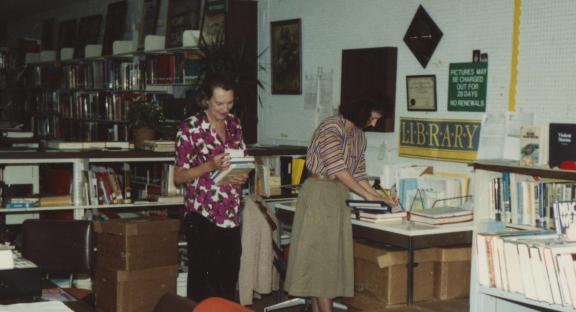
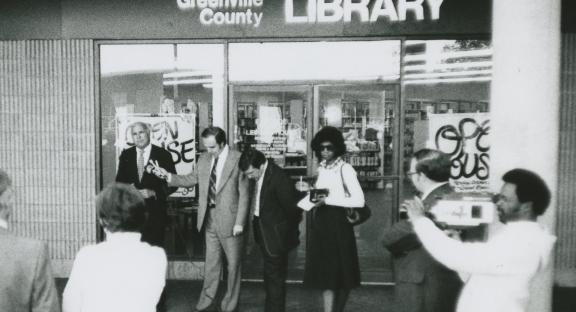

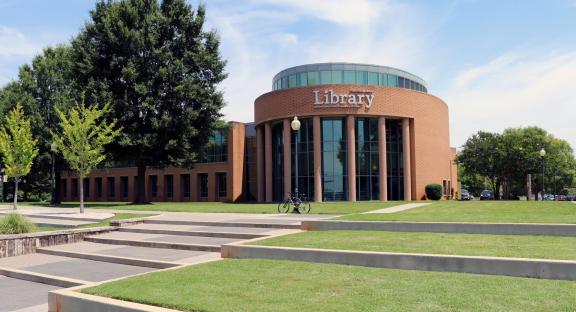
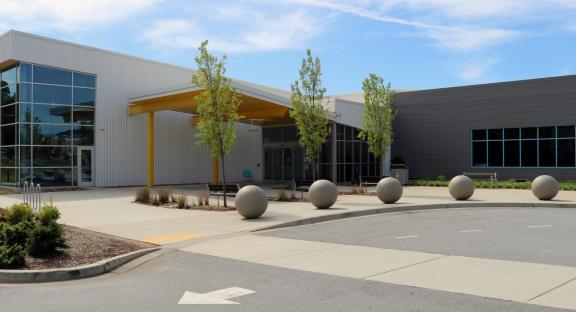
The Library opened on May 20, 1921 with 500 volumes in a vacant storage room on East Coffee Street in downtown Greenville and soon expanded into the space next door. The Library was so well received by the community that the City voted to provide tax support in 1923. The following year the library was moved to larger quarters in the Jervey Jordan building, which had entrances on both Main Street and Brown Street in downtown Greenville. (Image from the South Carolina Room Collection)
The Phillis Wheatley Center was founded in 1919 by local African-American educator Hattie Logan Duckett. During the 1920s, the center housed the first library serving African Americans in South Carolina. By the 1950s the library had outgrown this space, and a new branch serving African Americans opened in a repurposed commercial building on McBee Avenue. (Image courtesy of the Greenville County Historical Society)
On October 10, 1923, a new Library service was unveiled to the public. Known as the Pathfinder, this truck loaded up with library materials was the first ever bookmobile in the South and was created to meet the needs of Greenville’s mill communities. By January of 1924, the Pathfinder was on the road providing service to the Parker District, and by 1927, expanded its travels to the Travelers Rest area and other rural parts of Greenville County. At the height of the community’s need for this service, there were four bookmobiles making nearly 100 stops. (Image from the South Carolina Room Collection)
The Greer Library, founded in the fall of 1925, was the first Library branch in the County. Then in 1938, Greer became the first community to erect its own building, the Davenport Memorial Library on School Street. This new building featured a gathering place that was used by local clubs, including the USO during World War II. This meeting space later became the children's room as the branch’s collection grew. (Image from the South Carolina Room Collection)
In 1926, the Greenville County Library established a branch in Fountain Inn which was open only on Wednesday and Saturday afternoons. For 40 years, the branch resided in storefronts, but in 1965 the town of Fountain Inn bought land, and the Beaunit Corporation donated a building for the branch. (Image from the South Carolina Room Collection)
At one time the smallest library in the United States, the Tigerville Branch was built in the late 1920s and served northern Greenville County residents until July of 1976. It was located on the grounds of a grammar school located just off of Tigerville Road. (Image from the South Carolina Room Collection)
The Simpsonville Branch opened in 1926. Its beginnings were quite humble, merely one shelf of books located inside a furniture store at 104 South Main Street. The Bookmobile visited regularly and delivered fresh library materials to this rotating collection. In 1940, the Simpsonville Branch moved into a building built by the Works Progress Administration, which it shared with community groups who held meetings there. By 1968, the library had expanded to occupy the whole building, giving it 1800 square feet of space. (Image from the South Carolina Room Collection)
Before there was an Augusta Road Branch, there was "So Big," a diminutive building constructed in 1932. There, a librarian dispensed books from its 42 feet of shelving through a window to eager patrons outside. After the era of "So Big,” the Bookmobile continued to serve the Augusta Road area until 1975, when the growth of population in the area persuaded the Library Board to rent space next to the Pickwick Pharmacy on Augusta Road. Opened on March 4, 1975, the branch was instantly popular with patrons. (Image from the South Carolina Room Collection)
During the Depression years, few items were added to the collection, and staff often went without pay. In 1937, the end of the Library's lease in the Jervey Jordan building in downtown Greenville meant a move to temporary quarters in a garage building. The Library remained there for two years before the old Park School building on North Main Street was purchased. This new building was renovated and opened in 1940. (Image from the South Carolina Room Collection)
In the early years of the Library, books were brought to the Mauldin Branch on a rotating basis which included biweekly visits from the Bookmobile. Beginning in 1961, the branch’s collection expanded to fill two of the unused rooms in the town hall. After visiting this collection, textile entrepreneur Arthur Magill gifted a building for Library use which opened on East Butler Road in 1962. (Image from the South Carolina Room Collection)
On November 21, 1961, the Travelers Rest Branch first opened in three upstairs rooms provided by the Savings and Loan on Main Street. The Library supplied the books and a librarian, who was there three days per week. A decade after opening, the Travelers Rest Branch moved to roomier quarters in a storefront down the street. (Image from the South Carolina Room Collection)
In September 1960, the Main Street Library integrated in response to the efforts of Greenville’s African-American community. See the Service for All exhibit below to find out more. During the 1960s, the Greenville City and County public library services were combined, tax millage was raised to provide adequate support, and funds were solicited to build a new library. The new building opened on May 25, 1970 on the site of the Greenville Woman’s College on College Street in downtown Greenville. To the delight of library visitors, the City's first specially built library facility featured the recently donated Hollingsworth-Magill Memorial Globe. (Image from the South Carolina Room Collection)
In the 1970s, the community’s growth created a need for more library branches. The Berea Branch was established on November 1, 1971 and was soon followed the Taylors Branch on November 20, 1973. On July 5, 1975, the West Branch opened in a storefront at the corner of Easley Bridge Road and West Washington Avenue. (Image from the South Carolina Room Collection)
When the Vaughn's at East North Street Shopping Center opened in the fall of 1978, the Library leased 5,000 square feet of space for a new branch. It immediately became the branch with the highest book circulation. The steady rise in use of this Eastside Branch demanded a new building, which opened on October 7, 1990 on Pelham Road. (Image from the South Carolina Room Collection)
To meet the growing needs of the community, in 1993, the Greenville County Council approved an ordinance to replace nine existing library branches, replace the main library in downtown Greenville, and construct a new library for Woodruff Road. In September of 1995, the Greer Branch became the first of many free standing library buildings to be built or replaced. Other branches soon followed: Travelers Rest (1996), Simpsonville (1997), Berea (1998), Mauldin (1999), Fountain Inn (2002), Anderson Road (West Branch) (2003), Augusta Road (2004), and Taylors (2005). (Image from the South Carolina Room Collection)
As Greenville County stood at the gates of the new millennium, a new Main Library was built to provide more space to accommodate the community’s expanded use of technology. The result was the Hughes Main Library, which opened on October 7, 2002. (Image from the South Carolina Room Collection)
Construction of a new Library branch to serve the fast growing Woodruff Road area began in 2016. The Five Forks Branch opened on March 25, 2018. More than twice the size of the Library System’s other branches, it includes a drive-up window, a Play Porch for kids, and a variety of meeting spaces. (Image from the South Carolina Room Collection)
100 Years on the Road
1923–2023
Take a look back with us as the Greenville County Library System celebrates 100 years of public library service! The Greenville Public Library Association was chartered in May of 1921 to establish and maintain a free public library and to promote the “Modern Library Movement” in the City and County of Greenville. We celebrate our rich heritage today with a look back over the last 100 years.

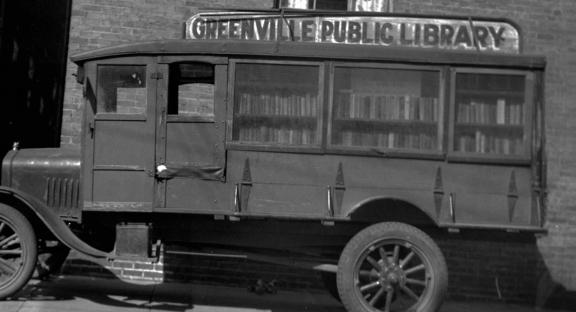



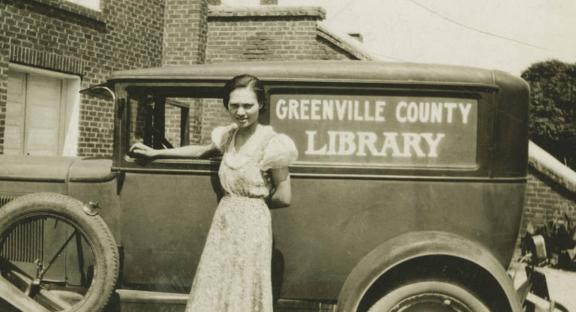
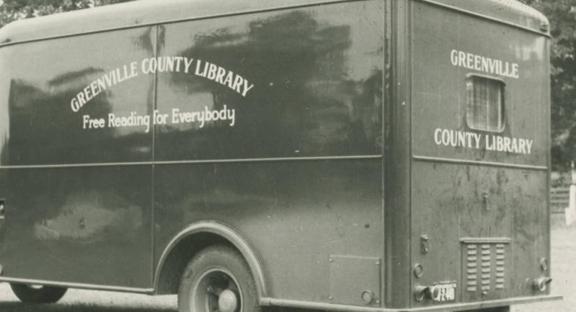
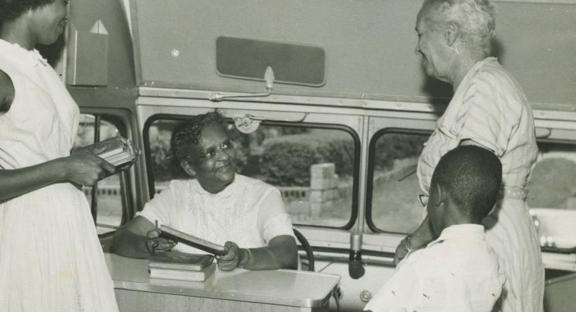
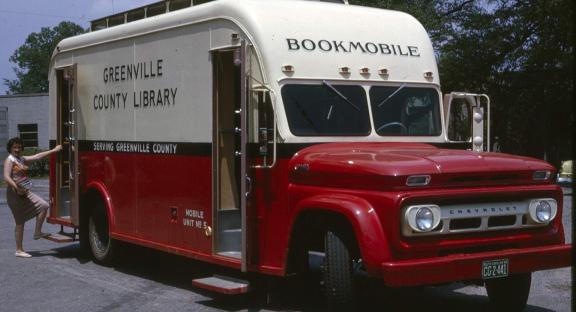


When it was time to name the Library’s first Bookmobile, Parker Schools Superintendent L.P. Hollis started a naming contest and offered a $10 prize to the winner. Two mill community residents, both patrons of the new book truck, suggested the name ‘Pathfinder.’ They split the prize money, and history was made. Librarian Nelle Barmore was the first to take the Pathfinder along its route through the Textile Crescent.
In the November 16, 1923 issue of the Joy Maker (The Parker Mills newspaper), librarian Charlotte Templeton reported that the Pathfinder had been incredibly successful in its first month of service. So successful, in fact, that more books had to be purchased from local booksellers in Greenville and ordered from Columbia and Atlanta to fulfill demand.
As word spread of the Library’s mobile book services, it became necessary to add additional vehicles. A second Bookmobile was purchased, and a book trailer was constructed that could be pulled behind the Bookmobile and dropped off at the most rural stops.
The Library established book deposits around the county once two Bookmobiles and the new branch libraries could not keep up with the needs of residents. These deposits were rotating collections of books placed in schools, shops, community centers, and private residences. The deposits were managed by residents and refilled by Bookmobile librarians at regular intervals (bimonthly, monthly or once every two months). In 1935, The Greenville News reported that the Library maintained six branch locations, 35 Bookmobile stops, and 161 book deposits.
Although Greenville’s public libraries were segregated until 1960, Bookmobile service was provided to African-American schools beginning in 1924, increasing access for Black patrons who were not able to visit the Phillis Wheatley Center’s small library collection. Annie Watters McPheeters was hired as the first African-American Bookmobile librarian in 1934. After working in Greenville for two years, she became the first professional African-American librarian in the Atlanta Public Library System, where she oversaw three branches and worked for the integration of public libraries.
The Library added its first walk-in Bookmobile in 1949. This Bookmobile held twice as many volumes as any of the previous models and included a checkout counter, bulletin board, and a heating and air conditioning system.
Carrie Wilson (seated at the counter) was the Bookmobile’s first full-time assistant. The New Washington Heights stop where this photo was taken was the Library’s first permanent African-American Bookmobile stop.
By the 1970s, the Library had a fleet of five Bookmobiles and made 76 stops every week. These stops included neighborhoods, apartment complexes, shopping centers, schools, and churches. Additional stops were added in the summer when children were not able to visit their school libraries.
As new branch libraries were opened in the 1990s, the need for Bookmobile stops declined, and the fleet of Bookmobiles was gradually phased out. The Library purchased this Bookmobile in 1991 to replace the older models, and it was used until 2006. In 1992, the Bookmobile made 33 stops every two weeks.
Today, the Bookmobile makes 16 stops each month, and outreach librarians serve over 100 homebound patrons. In 2022, nearly 13,000 items were checked out by Bookmobile patrons.
Service for All:
Integration of GCLS
Sit-ins that took place in March and July of 1960 led to the integration of all Greenville’s public libraries in September of 1960.


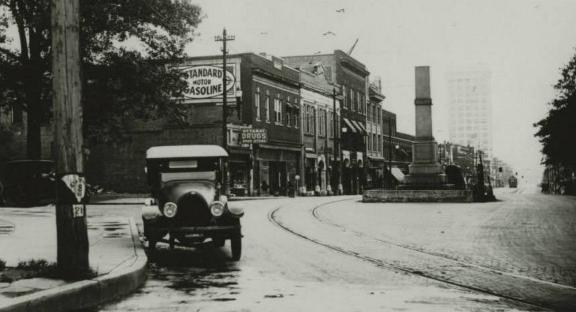


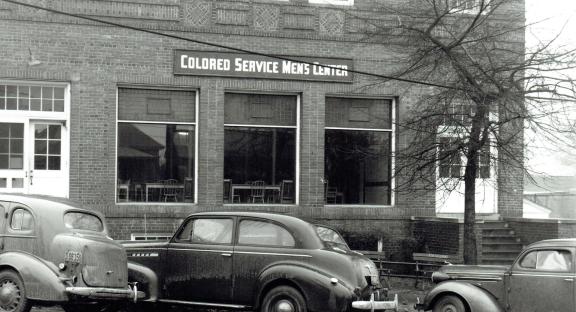
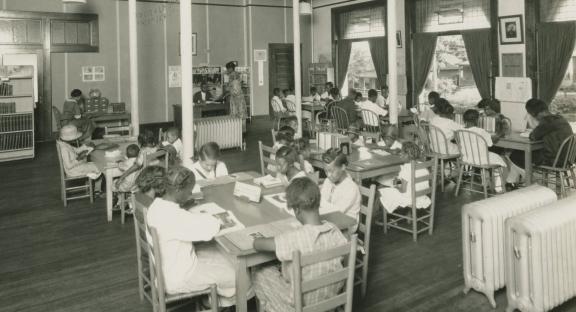
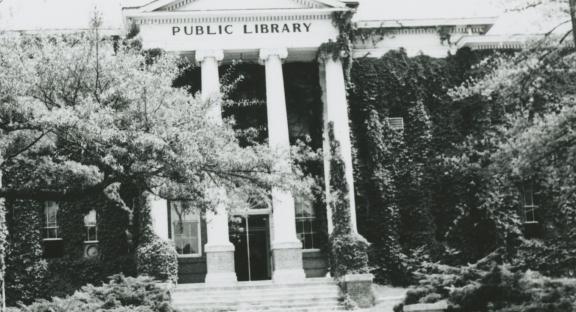
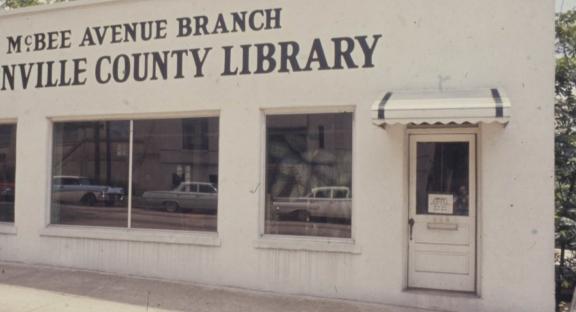
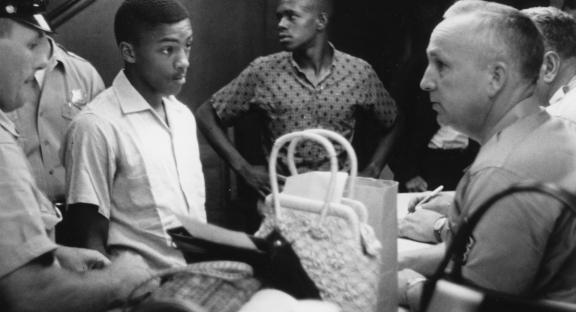



The Greenville Public Library Association was formed in 1921 at the height of the Jim Crow era. The US Supreme Court’s infamous 1896 decision (Plessy v. Ferguson) which established a “separate but equal” doctrine, resulted in legislation that discriminated against people of color. Throughout the South, laws requiring segregation were passed, and separation of the races was the law in early twentieth century Greenville. (Image from the South Carolina Room Collection)
In the beginning, Greenville’s dual libraries were both housed in rented rooms in the downtown area. It was a boom time for the city. World War I had just ended, the city was witnessing growth in the great textile mills and their villages, streets were being paved, and an electric trolley system circled the town. (Image from the South Carolina Room Collection)
The library’s founders were progressive and very determined to spread literacy throughout the city and county. Accordingly, the Phillis Wheatley Center, formed in 1919 by local African American educator Hattie Logan Duckett, was chosen to house the first African American library in South Carolina. The two libraries, however, were not equal. (Image from the Elrod Collection, courtesy of the Greenville County Historical Society)
Greenville County was the home of the South’s first bookmobile, which served both white and African American schools & communities. (Image from the South Carolina Room Collection)
During World War II, the Greenville Army Airbase, later Donaldson Center, was built in the southern part of the county. Because the airbase was segregated, the USO for colored soldiers was housed at the Phillis Wheatley Center. The library presence there was severely curtailed; hours were slashed and materials reduced. (Image from the Coxe Collection, courtesy of the Greenville County Historical Society)
Because of the crowding and lack of materials, Greenville’s African American citizens demanded better service and their own library building. (Image from the South Carolina Room Collection)
In 1940, a former school building on Main Street was purchased for the library which was only to be used by people who were not African-American. By 1947, this library reported a collection of 55,508 books compared to 11,644 at Phillis Wheatley. (Image from the South Carolina Room Collection)
By the 1950s, the demand for a new library resulted in the establishment of a re-purposed commercial building on McBee Avenue. (Image from the South Carolina Room Collection)
In March and July of 1960, students staged a series of peaceful protests against the segregation of the libraries. In what might be called "read-ins," groups of young African Americans entered the white library and quietly used its resources, perusing shelves of books or sitting at tables reading. Two of these protests resulted in the arrest of the participants on charges of disturbing the peace. (Image from the James Wilson Photograph Collection, courtesy of the Upcountry History Museum)
On July 16, 1960, seven students from Sterling High along with college freshman, Jesse Jackson, entered the library and were arrested. This group became known as 'The Greenville 8'. (Image from the James Wilson Photograph Collection, courtesy of the Upcountry History Museum)
On July 29, 1960, a federal lawsuit was filed in response to the arrest of seven Sterling High students who had entered the library in March. This group became known as 'The Greenville 7'. (Images from the 1960 edition of the Sterling High School Yearbook “The Torch” courtesy of the Greenville Cultural Exchange Center)
The Main Street library was integrated in September of 1960 in response to the lawsuit. The McBee Branch library closed in 1965 and a new fully integrated library was opened in 1970 on College Street in an area which is known today as Heritage Green. (Image from the South Carolina Room Collection)